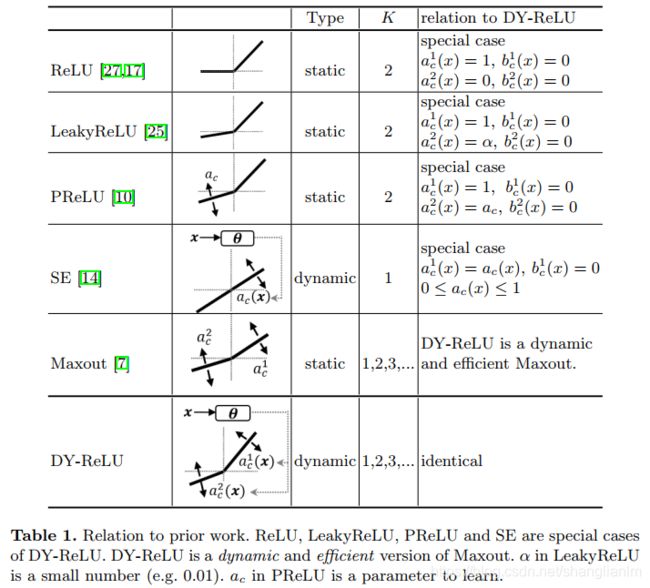深度学习论文:Dynamic ReLU及其PyTorch实现
Dynamic ReLU
PDF: https://arxiv.org/pdf/2003.10027.pdf
PyTorch代码: https://github.com/shanglianlm0525/PyTorch-Networks
1 DY-ReLU
提出的动态ReLU,能够根据输入动态地调整对应的分段激活函数,与ReLU及其变种对比,仅需额外的少量计算即可带来大幅的性能提升,能无缝嵌入到当前的主流模型中。

2 DY-ReLU变种
提供了三种形态的DY-ReLU,在空间位置和维度上有不同的共享机制。
- a) spatial and channel-shared DY-ReLU-A
- b) spatial-shared and channel-wise DY-ReLU-B
- c) spatial and channel-wise DY-ReLU-C
其中 b和c适用于分类任务,作为骨干网络,c适用作为头网络。

PyTorch实现:
import torch
import torch.nn as nn
import torchvision
import torch.nn.functional as F
class BatchNorm(nn.Module):
def forward(self, x):
return 2 * x - 1
class DynamicReLU_A(nn.Module):
def __init__(self, channels, K=2,ratio=6):
super(DynamicReLU_A, self).__init__()
mid_channels = 2*K
self.K = K
self.lambdas = torch.Tensor([1.]*K + [0.5]*K).float()
self.init_v = torch.Tensor([1.] + [0.]*(2*K - 1)).float()
self.avg_pool = nn.AdaptiveAvgPool2d(output_size=1)
self.dynamic = nn.Sequential(
nn.Linear(in_features=channels,out_features=channels // ratio),
nn.ReLU(inplace=True),
nn.Linear(in_features=channels // ratio, out_features=mid_channels),
nn.Sigmoid(),
BatchNorm()
)
def forward(self, x):
b, c, _, _ = x.size()
y = self.avg_pool(x).view(b, c)
z = self.dynamic(y)
relu_coefs = z.view(-1, 2 * self.K) * self.lambdas + self.init_v
x_perm = x.transpose(0, -1).unsqueeze(-1)
output = x_perm * relu_coefs[:, :self.K] + relu_coefs[:, self.K:]
output = torch.max(output, dim=-1)[0].transpose(0, -1)
return output
class DynamicReLU_B(nn.Module):
def __init__(self, channels, K=2,ratio=6):
super(DynamicReLU_B, self).__init__()
mid_channels = 2*K*channels
self.K = K
self.channels = channels
self.lambdas = torch.Tensor([1.]*K + [0.5]*K).float()
self.init_v = torch.Tensor([1.] + [0.]*(2*K - 1)).float()
self.avg_pool = nn.AdaptiveAvgPool2d(output_size=1)
self.dynamic = nn.Sequential(
nn.Linear(in_features=channels,out_features=channels // ratio),
nn.ReLU(inplace=True),
nn.Linear(in_features=channels // ratio, out_features=mid_channels),
nn.Sigmoid(),
BatchNorm()
)
def forward(self, x):
b, c, _, _ = x.size()
y = self.avg_pool(x).view(b, c)
z = self.dynamic(y)
relu_coefs = z.view(-1, self.channels, 2 * self.K) * self.lambdas + self.init_v
x_perm = x.permute(2, 3, 0, 1).unsqueeze(-1)
output = x_perm * relu_coefs[:, :, :self.K] + relu_coefs[:, :, self.K:]
output = torch.max(output, dim=-1)[0].permute(2, 3, 0, 1)
return output
if __name__=='__main__':
model = DynamicReLU_B(64)
print(model)
input = torch.randn(1, 64, 56, 56)
out = model(input)
print(out.shape)
